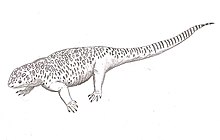| Asaphestera Temporal range:
Carboniferous,
| |
|---|---|

| |
|
Scientific classification
| |
| Domain: | Eukaryota |
| Kingdom: | Animalia |
| Phylum: | Chordata |
| Clade: | Synapsida |
| Genus: | †
Asaphestera Steen, 1934 |
| Type species | |
|
†Asaphestera platyris Steen, 1934
| |
Asaphestera is an extinct genus of a synapsid described on the basis of fossils from the Carboniferous of the Joggins locality in Nova Scotia, Canada. It was originally described as an undetermined lepospondyl [1] and subsequently classified as a microsaur within the family Tuditanidae. [2] A study published in May 2020 found that specimens referred to Asaphestera represented several unrelated species. Steen (1934)'s original species name Asaphestera platyris was retained for a skull which has been re-evaluated as the earliest known synapsid. [1] [3]
The type species of Asaphestera is Asaphestera platyris, named by Steen (1934) based on three skulls. Carroll & Gaskill (1978) noted that one of the skulls was briefly named as the species " Hylerpeton" intermedium by Dawson (1894), though it is no longer consider related to the genus Hylerpeton. According to Dawson's species name, they renamed Asaphestera platyris to Asaphestera intermedia. [4]
Mann et al. (2020) re-evaluated purported Joggins microsaurs and found several unusual results. One of the skulls assigned the name Asaphestera platyris by Steen appeared to be a valid taxon, but instead of a microsaur it was the oldest known synapsid, possibly an eothyridid. Dawson's "Hylerpeton" intermedium was determined to be an indeterminate tetrapod and a nomen dubium. Additional Asaphestera material was named as a new genus of microsaur, Steenerpeton. [3] Scales are preserved in the type specimen of A. platyris, [3] which are also observed in other early synapsids. [5] [6]
References
- ^ a b Steen, Margaret C. (1934). "The amphibian fauna from the South Joggins. Nova Scotia". Journal of Zoology. 104 (3): 465–504. doi: 10.1111/j.1096-3642.1934.tb01644.x.
- ^ "†Asaphestera Steen 1934". Paleobiology Database. Fossilworks. Retrieved 17 December 2021.
- ^ a b c Mann, Arjan; Gee, Bryan M.; Pardo, Jason D.; Marjanović, David; Adams, Gabrielle R.; Calthorpe, Ami S.; Maddin, Hillary C.; Anderson, Jason S. (5 May 2020). Sansom, Robert (ed.). "Reassessment of historic 'microsaurs' from Joggins, Nova Scotia, reveals hidden diversity in the earliest amniote ecosystem". Papers in Palaeontology. Wiley. doi: 10.1002/spp2.1316. ISSN 2056-2802.
- ^ Carroll, Robert L.; Gaskill, Pamela (1978). "The Order Microsauria". Memoirs of the American Philosophical Society. 126: 1–211.
- ^ Spindler, Frederik; Werneburg, Ralf; Schneider, Joerg W.; Luthardt, Ludwig; Annacker, Volker; Rößler, Ronny (2018). "First arboreal 'pelycosaurs' (Synapsida: Varanopidae) from the early Permian Chemnitz Fossil Lagerstätte, SE Germany, with a review of varanopid phylogeny". PalZ. 92 (2): 315–364. doi: 10.1007/s12542-018-0405-9. S2CID 133846070.
- ^ Voigt, S.; Calábková, G.; Ploch, I.; Nosek, V.; Pawlak, W.; Raczyński, P.; Spindler, F.; Werneburg, R. (2024). "A diadectid skin impression and its implications for the evolutionary origin of epidermal scales". Biology Letters. 20 (5). 20240041. doi: 10.1098/rsbl.2024.0041. PMID 38773928.





